Among the avian realm, crows stand out as remarkably intelligent creatures, captivating researchers and observers with their remarkable problem-solving abilities, complex social behaviours, and adaptability.
The question of how smart crows are in comparison to their feathered counterparts delves into the depths of avian cognition, challenging traditional notions of animal intelligence.
From employing tools to navigating intricate puzzles, crows exhibit a cognitive prowess that rivals and often surpasses that of many other bird species.
As we explore how smart are crows compared to other birds, we unravel not only the exceptional capabilities of these birds but also the fascinating spectrum of cognitive talents exhibited across different species.
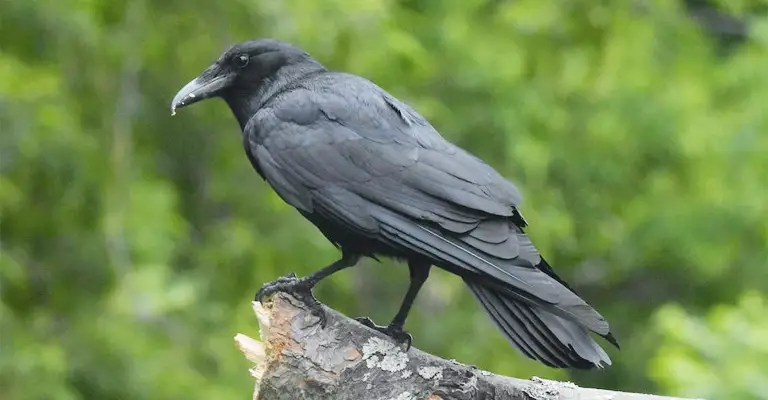
How Smart Are Crows Compared To Other Birds?
Crows are among the smartest birds in the world, and they can rival some primates in their cognitive abilities.
Here are the reasons why crows are so intelligent, based on the web search results:
Brain Size
Crows have relatively large brains for their body size, comparable to those of primates.
The size of the brain is an indicator of the potential for intelligence, as it reflects the number and complexity of neurons and connections. Crows have a brain-to-body mass ratio of about 2.7%, which is similar to that of chimpanzees.
Brain Structure
Crows have a different brain structure than primates, but they have evolved similar regions that are responsible for advanced cognition.
Crows have densely packed clusters of neurons called “nuclei” that function like the layers of the neocortex in primates. These nuclei are involved in learning, memory, planning, and problem-solving.
Tool Use
Crows are the only non-primates that can make new tools from different materials, such as sticks, wires, or leaves.
They can also modify existing tools to suit their needs, such as bending or sharpening them. Crows use tools to access food that is otherwise out of reach, such as insects inside holes or meat inside tubes.
Problem-solving
Crows can solve complex problems that require multiple steps, logic, and creativity.
For example, crows can figure out how to use a series of tools in a specific order to get a reward, such as dropping a stone into a tube to release a stick, then using the stick to pull out a string, then using the string to get a piece of meat.
Crows can also learn from their own experience and from observing other crows.
Memory

Crows have excellent memory and can remember faces, places, and events for a long time. Crows can recognize individual humans and associate them with positive or negative experiences, such as feeding or capturing.
Crows can also pass on this information to other crows or their offspring, creating a social memory network. Crows can also remember where they have hidden food and retrieve it later.
Communication
Crows have a sophisticated communication system that consists of various vocalizations and gestures.
Crows can produce different types of caws to convey different messages, such as alarm, threat, greeting, or coordination.
Crows can also modulate the intensity, rhythm, and duration of their caws to express different emotions or intentions. Crows can also use body language, such as wing flapping, head bobbing, or eye contact, to communicate with other crows.
Socialization
Crows are highly social animals that live in large groups called “murders”. Crows cooperate with each other for various purposes, such as finding food, defending territory, or mobbing predators.
Crows also form strong bonds with their mates and offspring and care for them until they become independent.
Crows also interact with other species of birds and animals, sometimes forming alliances or friendships.
Emotion
Crows have complex emotions and personalities that influence their behaviour and relationships. Crows can experience joy, sadness, anger, fear, curiosity, boredom, frustration, or affection.
Crows can also show empathy, compassion, gratitude, or revenge towards other crows or animals. Crows can also have individual preferences, habits, or quirks that make them unique.
Self-awareness
Crows have a sense of self-awareness that allows them to recognize themselves as distinct entities from others.
Crows can pass the mirror test, which is a test that measures whether an animal can recognize its own reflection in a mirror.
Crows can also use mirrors to inspect themselves or to find hidden objects behind them. Crows can also plan for the future and anticipate the consequences of their actions.
What Are Some Common Species Of Crows?
Crows are fascinating birds that belong to the genus Corvus, which includes more than 40 species of birds.
Some of the common species of crows are:
American Crow
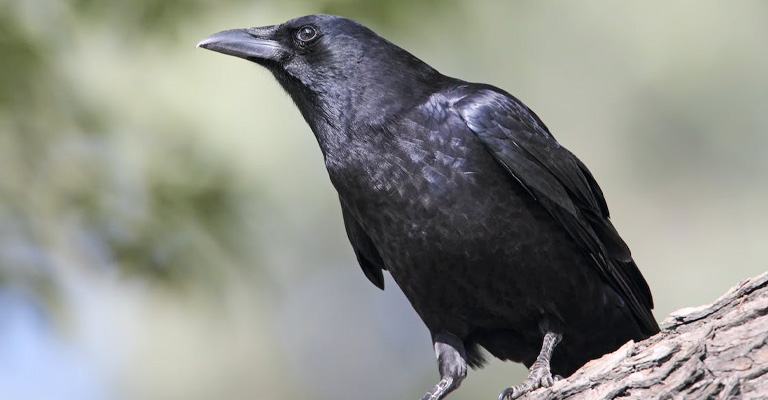
The American crow is a large black bird that lives in North America, from Canada to Mexico.
It is very adaptable and can be found in various habitats, such as forests, fields, cities, and suburbs. It feeds on a variety of foods, such as seeds, fruits, insects, worms, eggs, and garbage.
It is also very intelligent and can learn to use tools, mimic sounds, and communicate with other crows.
Carrion Crow
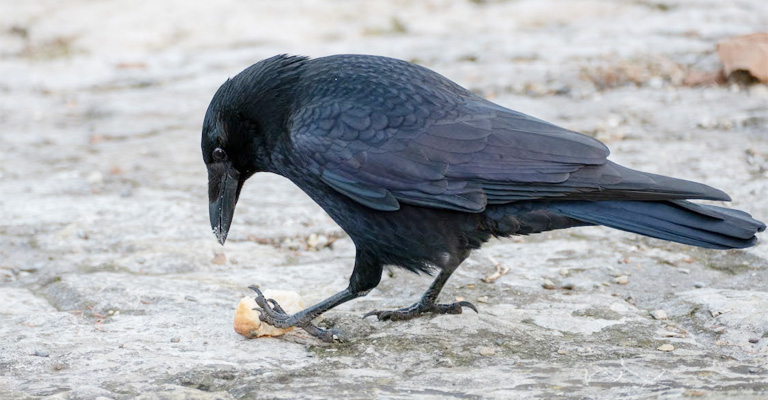
The carrion crow is a medium-sized black bird that lives in Europe and Asia. It is similar to the American crow but has a more square-shaped tail and a heavier bill.
It prefers open habitats, such as grasslands, farmlands, coasts, and urban areas. It feeds mainly on carrion but also eats insects, rodents, birds, eggs, and human food.
It is also very smart and can solve complex problems, remember faces, and cooperate with other crows.
Pied Crow
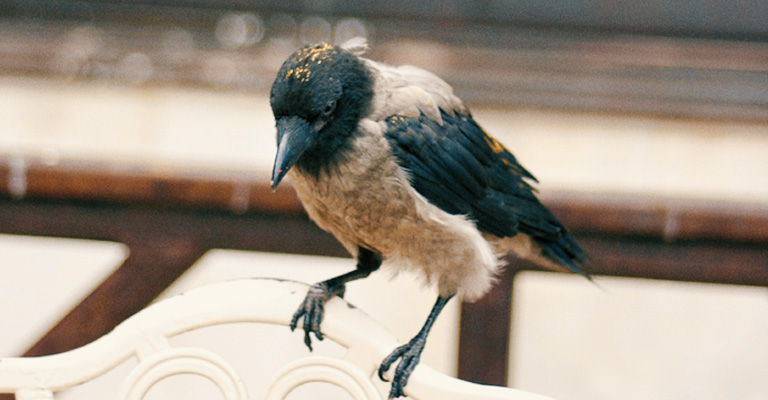
The pied crow is a large black-and-white bird that lives in Africa. It has a black head and chest and a white belly and neck. It is very social and often forms large flocks with other crows.
It inhabits various habitats, such as savannas, woodlands, deserts, and cities. It feeds on a wide range of foods, such as fruits, seeds, insects, reptiles, mammals, birds, eggs, and human food.
It is also very vocal and can imitate the sounds of other animals or humans.
House Crow
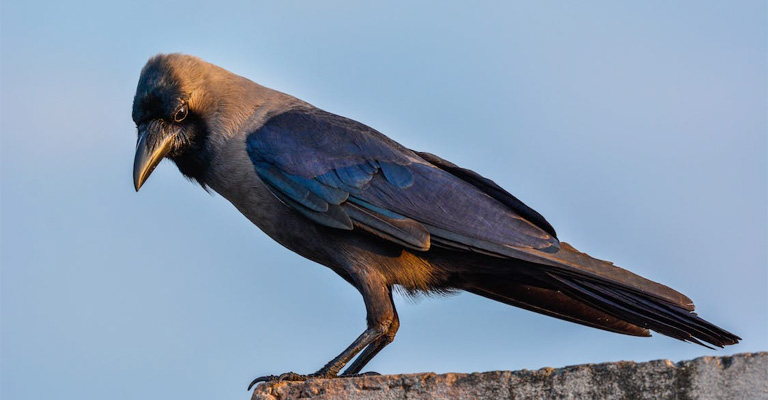
The house crow is a small dark grey bird that lives in Asia and Africa. It has a black head and wings and a grey body and neck. It is very adaptable and often lives near human settlements.
It feeds mostly on human food waste but also eats insects, grains, fruits, eggs, and small animals. It is also very cunning and can steal food from other birds or humans.
What Are Some Interesting Facts About Crows?
Crows are amazing birds that have many interesting facts about them. Here are some of them:
- Crows are very intelligent and can use tools, solve problems, remember faces, communicate with each other, and even hold grudges.
- Crows have a large and complex brain that is similar to that of primates. They have regions in their brain that are responsible for advanced cognition, such as learning, memory, planning, and reasoning.
- Crows are very social and live in large groups called murderers. They cooperate with each other to find food, defend territory, or mob predators. They also form strong bonds with their mates and offspring and care for them until they become independent.
- Crows have a sophisticated communication system that consists of various vocalizations and gestures.
They can produce different types of caws to convey different messages, such as alarm, threat, greeting, or coordination. They can also modulate the intensity, rhythm, and duration of their caws to express different emotions or intentions.
They can also use body language, such as wing flapping, head bobbing, or eye contact, to communicate with other crows.
- Crows are omnivorous and eat a wide range of foods, such as seeds, fruits, insects, worms, eggs, garbage, carrion, and even human food waste.
They can also adapt to different habitats and environments, such as forests, fields, cities, and suburbs.
- Crows can recognize themselves in mirrors and pass the mirror test, which is a test that measures whether an animal can recognize its own reflection.
They can also use mirrors to inspect themselves or to find hidden objects behind them.
- Crows can plan for the future and anticipate the consequences of their actions. They can also learn from their own experience and from observing other crows. They can also imitate the sounds of other animals or humans.
- Crows have complex emotions and personalities that influence their behaviour and relationships.
They can experience joy, sadness, anger, fear, curiosity, boredom, frustration, or affection. They can also show empathy, compassion, gratitude, or revenge towards other crows or animals.
- Crows have a special relationship with an eight-year-old girl who feeds them regularly. In return for her kindness, the crows give her little gifts such as a rusty screw, a button, a paper clip, and much more.
What Is The Iq Of Crows?
The IQ of crows is not easy to measure, as different species of crows may have different levels of intelligence, and different tests may measure different aspects of cognition.
However, some studies have attempted to estimate the IQ of crows by comparing them with other animals, such as primates, that are known to be intelligent.
One way to compare the intelligence of animals is to use the encephalization quotient (EQ), which is a measure of brain size relative to body size.
The EQ is a ratio of brain to body size but adjusted for size because there isn’t a linear relationship. Crows have an EQ of 4.1, chimps of 4.2, and humans of 8.11. But that is not the whole story.
Another way to compare the intelligence of animals is to look at their brain structure and function.
Crows have a different brain structure than primates, but they have evolved similar regions that are responsible for advanced cognition, such as learning, memory, planning, and problem-solving.
Crows have densely packed clusters of neurons called “nuclei” that function like the layers of the neocortex in primates. These nuclei are involved in learning, memory, planning, and problem-solving.
A third way to compare the intelligence of animals is to look at their behaviour and performance on various tasks. Crows have shown remarkable abilities in using tools, solving problems, remembering faces, communicating with each other, and even holding grudges.
Crows can make new tools from different materials, such as sticks, wires, or leaves.
FAQ
Yes, crows are often considered among the most intelligent birds due to their problem-solving skills, tool use, and complex social behaviors that surpass those of many other bird species.
Crows are known for their tool-making and tool-using abilities, memory skills, understanding of cause and effect, and even the ability to recognize themselves in mirrors—a sign of self-awareness.
Crows’ remarkable abilities include using tools to obtain food, solving multi-step puzzles, and recognizing human faces. Their advanced communication and social behaviours also contribute to their reputation for intelligence.
Yes, some other birds, like parrots, ravens, and certain species of jays, also display impressive problem-solving and social skills, although crows often stand out due to their widespread presence and adaptability.
Scientists use various cognitive tests to assess problem-solving, memory, tool use, and social interactions in different bird species. Comparing performance across these tests helps gauge the relative intelligence of crows compared to other birds.
Conclusion
In the grand tapestry of avian intelligence, crows undoubtedly shine as some of the brightest stars.
Their ability to solve complex problems, exhibit self-awareness and demonstrate an understanding of cause and effect places them among the elite ranks of intelligent animals.
While various bird species possess their own unique cognitive abilities, crows stand out for their versatile tool use, intricate social hierarchies, and adaptability to diverse environments.
As we continue to uncover the depths of avian cognition, crows serve as a reminder that intelligence comes in various forms across the animal kingdom.
Studying the intelligence of crows not only enhances our understanding of the avian mind but also offers insights into the evolution of intelligence itself.